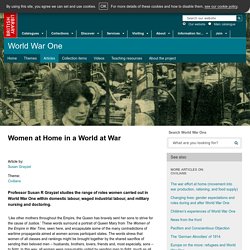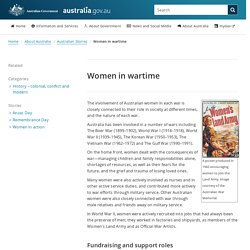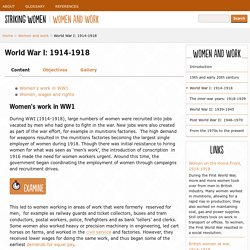

Women’s role and place. At the outbreak of war far fewer women than men participated in work, and these tended to be in lower-paid occupations.

Women’s main role was seen to be in the home. Oral historyWe began hearing a lot about 'the war effort' and people stopped saying the war would be over in six months, or even a year. Whenever I came home from school, the house was full of women clicking knitting needles and manipulating dark wool, and making huge quantities of socks, vests, mittens and mufflers, as well as sewing pyjamas and shirts. Mum ran Red Cross classes with first aid and bandage rolling... Mum, who was a leading light in the CWA (Country Women's Association) as well as the Red Cross, spent more and more of her time on the war effort...Nora Pennington, the good little girl who had written the composition about Gallipoli, was the school's champion sock knitter.
Cartoon from 'The Worker' 10 February 1916. DVA Women in War part2 0. BBC iWonder - What did World War One really do for women? Women at War in World War One. As the war progressed and more and more men were required to maintain the British army in the field, on the Home Front a manpower crisis loomed.

This problem was largely tackled by mobilising women to replace the men who had gone to fight. The role of women in securing victory cannot be underestimated; indeed, one of the reasons that Germany lost the war in 1918 was that she never succeeded in fully mobilising her female population. Although women had worked in some industries for many years, the First World War brought women into the workplace on a scale never before witnessed. Not only this, but in many cases these women came from the middle classes who had never previously experienced manual work. The most usual occupation for women pre-war was domestic service. GCSE Bitesize - The Home Front during the First World War.
12 Things You Didn't Know About Women In The First World War. Women at war - World War I and Australia - Research guides at State Library of New South Wales. Changing lives: gender expectations and roles during and after World War One. Considering the roles of both men and women during World War One, Susan R Grayzel asks to what extent the war challenged gender roles and to what degree society accepted them.

The First World War was a cataclysm that disrupted countless lives. As a modern, total war, it brought men and women into active battle zones across Europe as well as in parts of Africa and Asia. New technology further extended the borders of the war. Air power made it possible to launch attacks against civilian populations at some distance from traditional frontlines, and U-boats sank passenger ships, such as the Lusitania in 1915, that were loaded with men, women, and children crossing the Atlantic. In addition, albeit with less novelty, invading armies ended up occupying swathes of territory.
Postcard of German zeppelin that crashed on Fanø Postcard showing the German Zeppelin L3 after it crashed on the Danish island of Fanø, 1915. View images from this item (1) Women at Home in a World at War. Professor Susan R Grayzel studies the range of roles women carried out in World War One within domestic labour, waged industrial labour, and military nursing and doctoring.

‘Like other mothers throughout the Empire, the Queen has bravely sent her sons to strive for the cause of Justice.’ These words surround a portrait of Queen Mary from The Women of the Empire in War Time, seen here, and encapsulate some of the many contradictions of wartime propaganda aimed at women across participant states. The words stress that women of all classes and rankings might be brought together by the shared sacrifice of sending their beloved men – husbands, brothers, lovers, friends and, most especially, sons – to fight. In this way, all women were presumably united by sending men to fight, much as all men were united in their willingness to take up arms on behalf of their nation. Copyright: © Dominion of Canada News Co. Women in wartime. A poster produced in 1943 encouraging women to join the Land Army.

Women in action - nurses and serving women. A WAAAF Meteorological Officer adjusting a theodolite, 1942.

Image courtesy of Australian War Memorial. Women in action - nurses and serving women. Women in wartime. World War I: 1914-1918. Women's work in WW1 During WWI (1914-1918), large numbers of women were recruited into jobs vacated by men who had gone to fight in the war.

New jobs were also created as part of the war effort, for example in munitions factories. The high demand for weapons resulted in the munitions factories becoming the largest single employer of women during 1918. Though there was initial resistance to hiring women for what was seen as ‘men’s work’, the introduction of conscription in 1916 made the need for women workers urgent. Around this time, the government began coordinating the employment of women through campaigns and recruitment drives. Examine Examine Watch this women on the home front.html and this women at war.html Now answer the following questions: How many jobs can you identify women undertaking in the two video clips?
By 1917 munitions factories, which primarily employed women workers, produced 80% of the weapons and shells used by the British Army (Airth-Kindree, 1987). Discuss Discuss Compare.